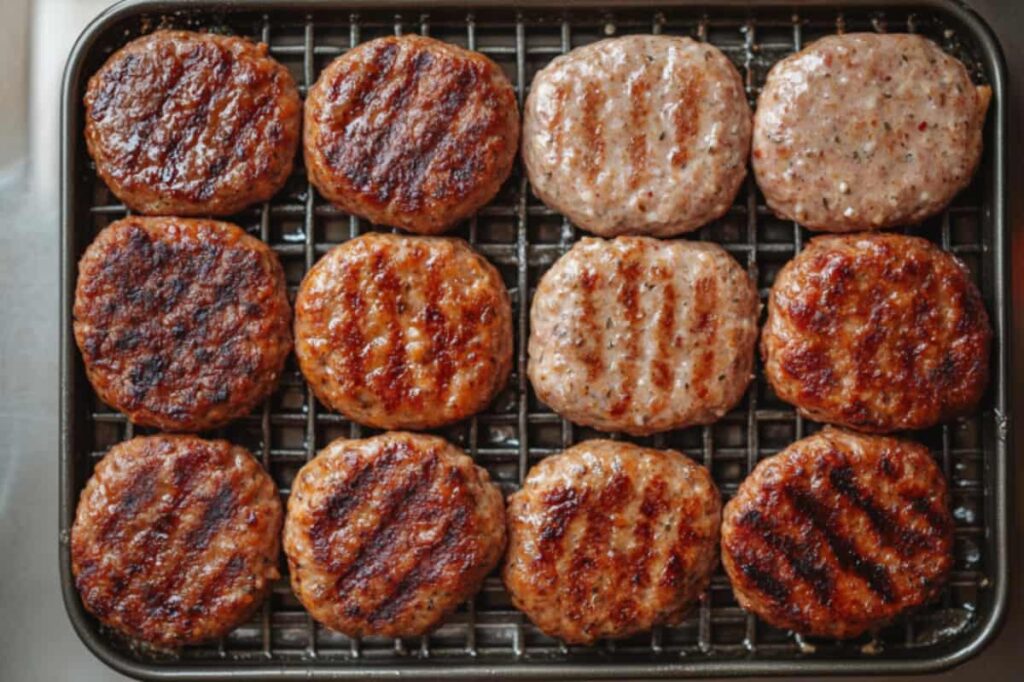Savory, convenient, and versatile, chicken sausage patties tempt many breakfast lovers. But are chicken sausage patties healthy? Let’s uncover the facts.
1. Understanding Chicken Sausage Patties
Chicken sausage patties are a popular alternative to traditional pork or beef sausages. They feature ground chicken blended with various spices, herbs, and often a binder to help the mixture form cohesive patties. Because chicken is naturally leaner than most red meats, these patties may offer comparatively less fat. Nevertheless, manufacturers often add oils or skin to boost flavor and juiciness.
Many people choose chicken sausage patties to limit saturated fat intake. However, certain brands might contain added sodium, nitrates, or filler ingredients. Consequently, it’s crucial to read nutrition labels. Another factor to consider is seasoning content. Herbs like sage, thyme, or rosemary impart appealing aromas. Yet, some mass-produced patties can include additional sugars or flavor enhancers.
Altogether, chicken-based options tend to be a worthwhile choice for those seeking a lighter alternative. However, moderation matters. Equally significant is paying attention to how the patties fit into your daily nutrient goals. Indeed, if you select high-quality chicken sausage and prepare it in a healthy way, you can enjoy these patties as part of a balanced diet.
Finally, when you hear people ask, “Are chicken sausage patties healthy?” the short answer depends on your overall eating habits and the specific product you buy.
2. Are Chicken Sausage Patties Healthy?
One of the main attractions of chicken sausage patties lies in their reduced fat content compared to pork options. Because they often have lower levels of saturated fat, they can be easier on the heart. However, calories can vary significantly depending on the brand or recipe. Thus, it is wise to compare labels before making a final selection.
Additionally, some chicken sausage products are free of antibiotics and hormones. Many consumers seek such labels for peace of mind. However, cost is often a factor when opting for specialty or organic varieties. Another point to consider is whether patties contain extra fillers. These might add calories without contributing significant nutrients. Consequently, checking ingredient lists is crucial.
Protein is a chief benefit of these patties. They deliver essential amino acids for muscle maintenance. Are chicken sausage patties healthy? for Breakfast Fans.
Many breakfast enthusiasts find that a morning meal including one or two chicken sausage patties offers satisfying protein. Pairing them with whole-grain toast or fresh fruit supports a balanced diet. Furthermore, these patties can help keep you full throughout busy mornings. Nonetheless, watch for sodium. High intake can lead to water retention and potential health concerns. Selecting reduced-sodium products is often a better choice.
3. Key Nutritional Factors
Understanding the nutritional breakdown of chicken sausage patties can help you make smarter decisions. Typically, each patty delivers about 60–100 calories, depending on size and ingredients. Because most patties supply around 6–10 grams of protein, they can be a convenient source of this key nutrient. Basically, chicken offers a lean protein that supports muscle repair and growth.
Fat content varies. Some patties have only 2–3 grams of fat, whereas others can climb up to 7–8 grams. Pay attention to saturated fat, as diets high in saturated fat can negatively affect cardiovascular health. Equally, not all fats are bad. Some products may contain healthier unsaturated fats, particularly if the chicken is combined with olive oil or a similar ingredient.
Another vital factor is sodium. Many sausages depend on salt to enhance flavor. Therefore, some patties contain 300–600 milligrams of sodium or more per serving. Moderation remains key to avoiding excessive sodium intake. Finally, watch for added sugars. Chiefly, sweeteners like dextrose can lurk in processed meats. While they often appear in small amounts, they can add up if you eat multiple servings. By checking nutrition labels, you can explicitly choose the best options that align with your health goals.
4. Are Chicken Sausage Patties Healthy?
Individuals with busy schedules often rely on quick meals, and chicken sausage patties can fulfill that need. These patties cook faster than many other proteins. Comparatively, they offer a handy way to include poultry in your morning meal. Yet, when people ask, “Are chicken sausage patties healthy?” for Active Lifestyles, the answer involves considering the quality of the meat, the brand, and the cooking method.
For those engaged in sports or workouts, a moderate serving can provide an instant protein boost. Meanwhile, the fat content can help maintain energy levels. Nonetheless, portion control is crucial. Overeating any sausage patty, no matter how lean, can lead to excess calorie intake. Another strategy involves pairing patties with complex carbohydrates and fiber-rich vegetables. This approach improves overall nutrient balance.
Subsequently, people on weight management plans often appreciate the portion size convenience. One or two patties can be measured easily, thus helping with calorie tracking. Nonetheless, keep an eye on any hidden additives. Some products boast extra flavor enhancers or preservatives that might detract from overall health benefits. Indeed, focusing on whole-food sides, like fresh spinach, tomatoes, or avocado, can further elevate the nutritional profile of these chicken-based patties.
5. Preparation Tips

Cooking technique influences the final healthfulness of chicken sausage patties. Initially, pan-frying may seem quick, but it often requires additional oil or butter. Choosing a non-stick skillet and using minimal oil can reduce total fat content. Likewise, baking is a popular method. Simply arrange patties on a parchment-lined tray, and bake until internal temperatures reach a safe level, usually 165°F. This approach evenly cooks your patties while minimizing extra fat.
Grilling also remains an excellent option. It drains rendered fat away and can provide a smoky flavor. Consequently, you get a savory taste without heavy oils. Another tip is to experiment with herbs and spices when preparing homemade chicken patties. For example, rosemary, thyme, parsley, paprika, and garlic can add robust flavor. You can skip packaged mixes that might carry excess sodium or preservatives.
Additionally, consider your serving style. Are you pairing these patties with high-fat sides like fried eggs and cheese grits? Balancing them with nutrient-dense foods—like fresh vegetables or whole grains—keeps your meal wholesome. Chicken sausage patties can be tasty and beneficial when cooked with care. Therefore, adopting healthy cooking methods can help you answer the question, “Are chicken sausage patties healthy?” with a confident yes.
6. Are Chicken Sausage Patties Healthy?

Balanced eating stems from combining various food groups and nutrients. This principle also applies to chicken sausage patties. When part of a well-rounded diet, these patties can comfortably fit into daily meals. Many nutritionists emphasize variety. Hence, try not to rely solely on chicken sausage for protein. Incorporate fish, legumes, and lean beef occasionally.
Still, people ask, “Are chicken sausage patties healthy?” for Balanced Eating. The short answer is yes, with a few considerations. Focus on portion sizes and side dishes. Pair patties with leafy greens or fruit to add vitamins and minerals. If you crave bread, opt for whole wheat for added fiber. Moderation is vital, and your entire day’s food choices contribute to overall health.
Additionally, watch for any cooking oils you use. Olive oil or avocado oil can be better than butter or margarine. Meanwhile, thoroughly cooking patties ensures safety from bacteria. Undoubtedly, a balanced plate also helps maintain stable blood sugar levels, especially if you include complex carbohydrates and vegetables. Ultimately, chicken sausage patties fit well into many eating plans, particularly for individuals looking for a lower-fat alternative to pork or beef sausages.
7. Common Myths and Misconceptions
People often associate sausages with high fat and excessive sodium. Accordingly, they may label all sausages as poor dietary choices. However, chicken sausage patties prove that not all sausage products are alike. For instance, some fear that every brand is ultra-processed. While chicken sausage is technically processed, many manufacturers use relatively simple techniques involving ground meat and spices.
Another myth is that these patties must be bland if they contain less fat. Conversely, they can be incredibly flavorful if seasoned properly. Furthermore, some individuals worry that all chicken sausage contains nitrates and preservatives. In reality, many brands now offer nitrate-free varieties with fewer additives. Check the packaging carefully to find a product aligning with your health goals.
Some people assume that cheaper patties automatically mean lower quality. While cost can reflect the source and care of the ingredients, it’s still possible to find budget-friendly, healthier options. Reading nutrition facts helps you spot hidden pitfalls, such as added sugars or artificial flavors. Altogether, debunking these misconceptions reveals that chicken sausage patties can be an excellent choice for those who enjoy sausage but want a leaner, protein-rich alternative. Nonetheless, always look for reputable brands and practice moderation.
8. Conclusion
Are chicken sausage patties healthy? The verdict depends on how you select, prepare, and serve them. Basically, high-quality chicken sausage patties can offer a leaner alternative to pork or beef while providing decent protein. Consequently, they can fit into various meal plans, from hearty breakfasts to light lunches. Indeed, these patties can be especially attractive to individuals aiming to cut down on saturated fat.
Nonetheless, it’s important to pay attention to sodium levels and potential additives. Furthermore, using healthy cooking methods, like baking or grilling, can help you avoid excess oil. Pair these patties with nutrient-dense sides, including vegetables, fruits, and whole grains. Eventually, the combination of wholesome ingredients can help you make the most of chicken sausage patties without compromising your health goals.
Remember that variety matters. Relying on a single source of protein, even one that seems healthy, might limit the overall nutrient profile of your diet. Thus, incorporate other lean proteins like fish, turkey, eggs, or beans. By focusing on balance, you can enjoy chicken sausage patties as part of a nutritious lifestyle and confidently answer the question, “Are chicken sausage patties healthy?” with a balanced perspective.
9. Frequently Asked Questions (FAQs)
Is chicken sausage healthier for you?
Many people choose chicken sausage because it often has lower saturated fat and calories compared to pork versions. This difference can make it a favorable option for individuals watching their cholesterol or overall caloric intake. However, the term “healthier” depends on factors like brand, ingredients, and cooking method. High-quality chicken sausage typically contains leaner cuts of meat and fewer artificial additives. Still, pay attention to sodium content, as it can be surprisingly high in certain varieties. Furthermore, keep an eye on portion sizes, because eating too many patties can lead to excessive calorie intake. All things considered, chicken sausage can be a nutritious protein source, provided you pick options with minimal fillers and cook them in a way that reduces added fat.
Are sausage patties healthy for you?
Sausage patties come in many forms, including pork, beef, turkey, and chicken. Consequently, their healthiness varies widely. Traditional pork sausage patties often have high fat levels, which can raise concerns about heart health if eaten regularly. Chicken patties may contain less saturated fat and thus be a slightly better choice. Nonetheless, the presence of preservatives, added sugars, or artificial flavors can reduce overall nutritional value. Checking the label helps you identify potential red flags, such as trans fats or excess sodium. In the end, sausage patties—regardless of the protein source—are best consumed in moderation. Balancing them with fruits, vegetables, and whole grains helps maintain a diverse diet. When it comes to deciding if chicken sausage patties rank as healthy, it ultimately depends on the product’s quality and how they fit into your daily meal plan.
Is chicken sausage considered processed meat?
Yes, chicken sausage typically falls under the category of processed meat because it is altered from its original state. Common processing steps include grinding, mixing with seasonings, and sometimes curing or smoking. Because processed meats can contain high amounts of sodium or nitrates, health experts often suggest limiting their consumption. Nonetheless, not all processed meats are equal. Some chicken sausages feature simpler ingredient lists with fewer additives. If you want to reduce your intake of highly processed foods, look for labels that highlight fewer preservatives or mention “nitrate-free” or “uncured.” Additionally, it helps to select organic or antibiotic-free chicken when possible, especially if you prioritize overall quality. Processing methods vary among brands, so investigating labels remains your best approach to selecting a healthier product.
Can we eat chicken sausage in a diet?
Absolutely, you can incorporate chicken sausage patties into a balanced diet. Particularly when you opt for lean, minimally processed products, they can serve as a convenient and tasty source of protein. Nevertheless, it’s best not to rely solely on chicken sausage for your daily protein needs. Instead, mix things up with fish, eggs, beans, and other lean meats. This variety ensures you receive different vitamins, minerals, and essential amino acids. Moreover, cooking methods influence a patty’s final nutritional profile. Techniques such as grilling, baking, or air-frying can help minimize added fats. Meanwhile, pairing chicken sausage with nutrient-dense sides like leafy greens, whole grains, or fresh fruit can round out your meal. Undoubtedly, portion control remains key. One or two patties will likely meet your protein requirements without contributing too many calories or grams of sodium.

